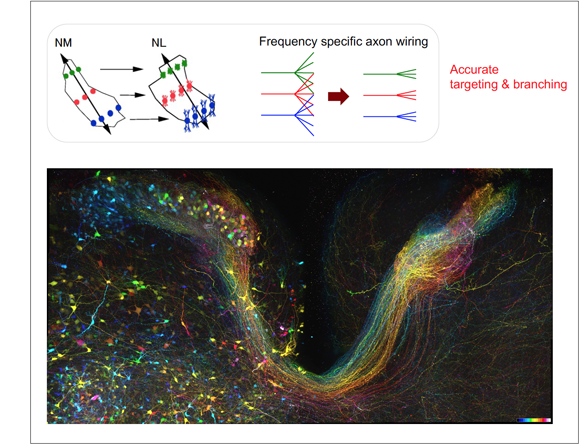Research
Outline

Brain is composed of over 100 billions of neurons. Neurons are highly differentiated in their morphological and biophysical properties. Furthermore, they are interconnected with each other via synapses, thus creating complex neural circuits. Recent advances in neuroscience give us a wealth of knowledge on the anatomical basis of neural circuits and also the properties of individual neurons and synapses. However, how these features actually shape specific functions of neural circuits is not well understood. We are addressing this issue by multidisciplinary approaches, including electrophysiology, optics, morphology, molecular biology, and computations.
Cellular and molecular mechanisms of binaural spatial hearing

Sound localization is a behavior to identify the direction of sounds and requires detecting a difference in sound arrival times between the two ears. We can resolve as small as 1 degree of sound source changes along the horizontal plane, which corresponds to 10 microseconds of interaural time difference. This resolution of time is outstanding, considering that action potentials often have duration in the order of a millisecond in the brain. We are interested in how such a small time difference is extracted in brainstem auditory circuits, particularly focusing on tonotopic differentiation of neurons within the circuits. We are also studying how the properties of these circuits are acquired in response to sensory inputs during development.
Structural plasticity at the axon initial segment

Axon initial segment (AIS) is a highly specialized neuronal structure that separates axonal and somatodendritic compartments. AIS is enriched with voltage-gated Na channels, and plays a critical role in initiating action potentials. We showed in brainstem auditory neurons that deprivation auditory nerve activity increased the length of AIS, thereby enhancing the excitability of the neurons. This indicates that AIS is highly plastic and changes its structure to regulate neuronal activity. Neural activity is crucial for the maintenance of neural circuit. Thus, this reorganization of AIS may work as a homeostatic mechanism to compensate for the loss of auditory nerve activity, thereby contributing to the maintenance of auditory circuits after hearing loss. We are now elucidating properties, mechanisms, and function of this AIS plasticity. The findings will reinforce our knowledge on how neural circuit function is achieved and maintained in an experience dependent manner.
Mechanisms underlying region-specific spacing of Ranvier nodes

We are studying the mechanisms by which oligodendrocytes regulate conduction velocity along axons in a region specific manner.
Principles of regulating axonal wiring

We are studying the mechanisms of timing- and region-specific regulation of axon branching in the sound localization circuit.
